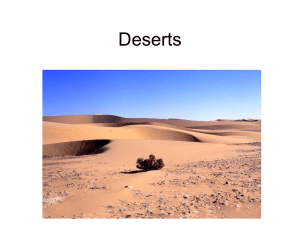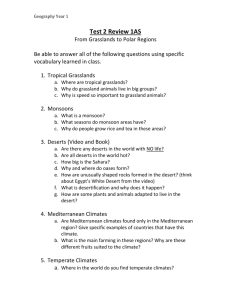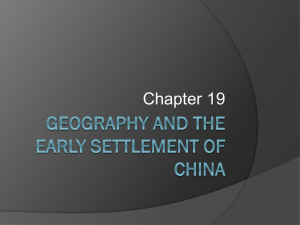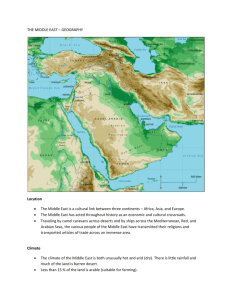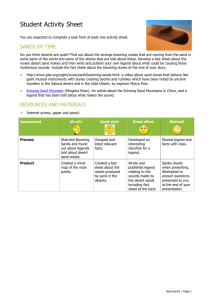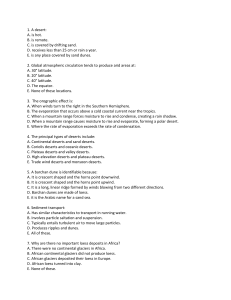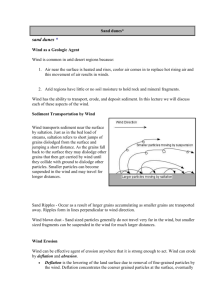Wind and Deserts
advertisement
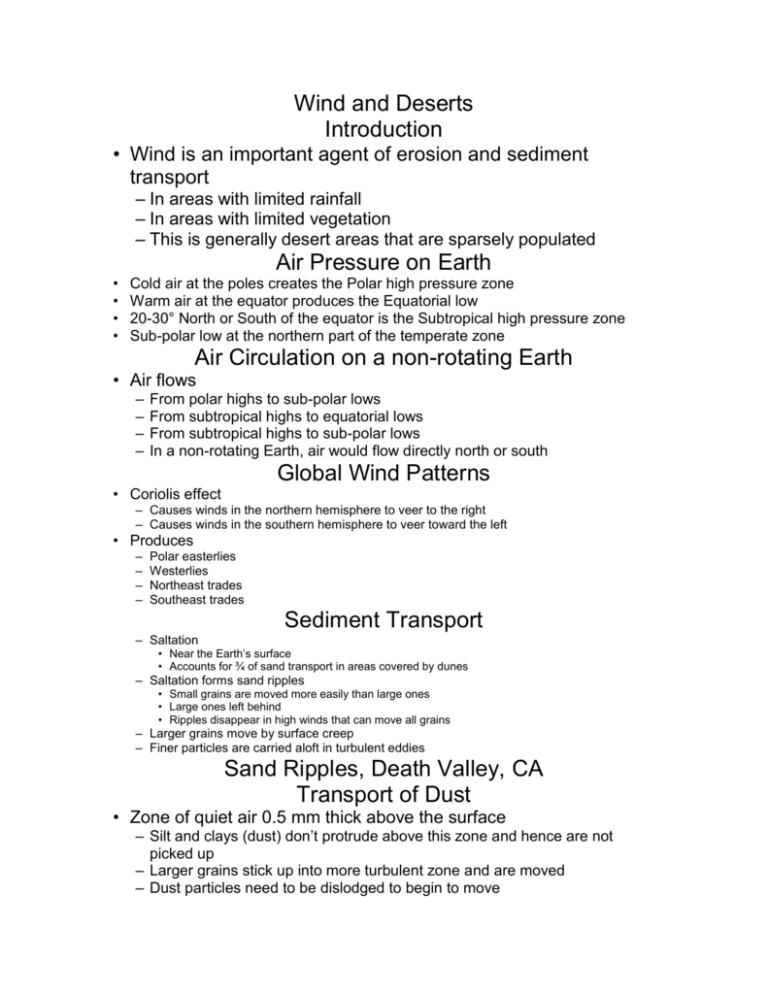
Wind and Deserts Introduction • Wind is an important agent of erosion and sediment transport – In areas with limited rainfall – In areas with limited vegetation – This is generally desert areas that are sparsely populated Air Pressure on Earth • • • • Cold air at the poles creates the Polar high pressure zone Warm air at the equator produces the Equatorial low 20-30° North or South of the equator is the Subtropical high pressure zone Sub-polar low at the northern part of the temperate zone Air Circulation on a non-rotating Earth • Air flows – – – – From polar highs to sub-polar lows From subtropical highs to equatorial lows From subtropical highs to sub-polar lows In a non-rotating Earth, air would flow directly north or south Global Wind Patterns • Coriolis effect – Causes winds in the northern hemisphere to veer to the right – Causes winds in the southern hemisphere to veer toward the left • Produces – – – – Polar easterlies Westerlies Northeast trades Southeast trades Sediment Transport – Saltation • Near the Earth’s surface • Accounts for ¾ of sand transport in areas covered by dunes – Saltation forms sand ripples • Small grains are moved more easily than large ones • Large ones left behind • Ripples disappear in high winds that can move all grains – Larger grains move by surface creep – Finer particles are carried aloft in turbulent eddies Sand Ripples, Death Valley, CA Transport of Dust • Zone of quiet air 0.5 mm thick above the surface – Silt and clays (dust) don’t protrude above this zone and hence are not picked up – Larger grains stick up into more turbulent zone and are moved – Dust particles need to be dislodged to begin to move Deposition of Dust • Happens because – Wind velocity decreases – Particles collide with rough or moist surfaces that trap them – Particle accumulate to form aggregates which settle out because of their mass – Particles are washed out of the air by rain – Vegetation acts as a trap – When a topographic obstacle gets in the way Effect of Obstacles Problems of Windblown Sediment • Loss of soil material • Blowing sand can damage crops • Animals suffer – Cattle asphyxiated by dense dust – Hair and skin sandblasted from their hind quarters • • • • Windshields can be frosted Engines are damaged by dust Reduction of visibility Medical problems for humans by inhalation of dust Major Dust Storms Wind Deflation • Produces depressions called blowouts • Can remove soil • Produced depressions, now known as spungs in South Jersey – South Jersey was a polar desert during the Pleistocene • Ground was frozen in a continuous or discontinuous permafrost • Sand was blown away until the surface encountered the water table, or permafrost Wind Deflation Desert Pavement • Deflation leads to removal of fines • Coarse particles left behind • Forms a desert pavement Abrasion • Ventifacts – Wind sculpted particles – Smooth surface, but often with abrasion marks – Angular junctions of faces Eolian Deposits • Dunes – Ridge of deposited sand – Probably develop around a surface irregularity – Typically asymmetrical • Gentle slope up wind • Steep slope downwind • Slip face at angle of repose – Migrate downwind Dune Types Loess • Wind-deposited dust – Thicker than the little bit of wind-blown dust that is practically everywhere – Largely silt-sized, but with some fine sand and clay – Resource because productive soils develop on it as parent material • Key characteristics – Forms uniform blanket – Contains fossils of land plants and air-breathing animals Loess • Sources – Deserts – Floodplains of glacial melt-water streams • • • • • Middle part of North America East-central Europe Similar composition to other glacial materials Thickest downwind from former braided melt-water streams Deposits thin downwind Loess in the Central US Wind-Blown Dust on the Seafloor Deserts • Now defined as areas where annual rainfall is less than 250 mm (10 inches) • Or where potential evaporation rate exceeds precipitation rate • 25% of the land area outside the polar regions • Types – Subtropical Deserts • Two most extensive belts of deserts are associated with belts of dry, descending air centered between 20° and 30° North or South of the equator • Sahara, Kalahari, Rub-al-Khali, Australian Deserts of the World Deserts • Continental Interiors – Land areas far from coasts and sources of moisture – Gobi, Takla Makan in Asia • Rainshadow – Mountains create a barrier to water-bearing winds – Form on the lee side of mountains in the “rain shadow” – Eastern sides of the Cascades and Sierra Nevada Deserts • Coastal Deserts – Places where cold, upwelling seawater cools air blowing on shore – As the air encounters the warm coast it contains too little moisture – Coastal deserts of Peru and southwestern Africa • Polar Deserts – Precipitation is low due to sinking of cold, dry air – Water is in the form of ice Desert Climate • Dry • Temperature fluctuations – Very hot during the day • 139.5 °F is record high in the Libyan desert of North Africa • Other, appropriately located deserts get hot during the day – Cool off dramatically at night • Little or no cloud cover allows radiational cooling • Windy – Heated air rises during the day drawing in more air to replace it Weathering and Mass Wasting • Dryness – Lack of vegetation – Relatively slow chemical weathering – Importance of mechanical weathering • Mechanical weathering produces distinctive landforms – Flat-lying sedimentary rocks that are eroded produce characteristic features • Mesa—table top mountains • Butte—narrow, flat-topped hill or spire Weathering and Mass Wasting • Desert Varnish – Thin, dark, coating of manganese oxide – Formed by prolonged exposure to air – Manganese may come from desert dust or by microoganisms that release it Desert Varnish Fluvial Processes • Flash floods – Rain comes in bunches – Little vegetation to impede flow – Arroyos • Stream valleys • Filled during flash floods • Dry much of the time Arroyo Fluvial Processes • Alluvial fans – Delta on land – Produced where streams flow out of the mountains onto flat valley floors • Bajada—Coalescing alluvial fans • Playa—lakebed on the floor of a desert valley Playa and Bajada Fluvial Processes • Pediment – Broad, relatively flat surface eroded across bedrock, and thinly covered with alluvium Pediment in the Mojave Fluvial Processes • Inselbergs – Erosion remnants – Isolated knobs, rocks, or hills – Form in areas of homogeneous, resistant rocks surrounded by less resistant rock Inselberg Desertification • Expansion of desert areas – Can result from natural or man-triggered climate changes – Symptoms • • • • • Declining groundwater tables Increasing saltiness of water and topsoil Reduction in supplies of surface waters Unnaturally high rates of soil erosion Destruction of native vegetation Desertification Advancing Barchans in Egypt
